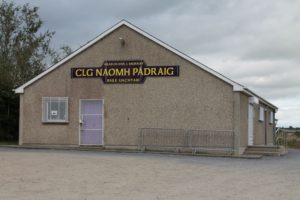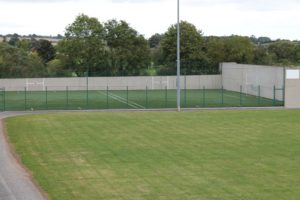St. Patrick's GAA (Ballyoughter)
St. Patrick’s (Ballyoughter) first participated as a parish GAA club in 1905. The next foray for the club into sporting action was in 1940 and again in 1941. It wasn’t until 1956 that St. Patrick’s began an unbroken run as a competitive club which continues to this day.
Before the club’s return to the GAA fold in 1956, its predecessor, Valley Rovers, had been formed in 1952 comprising players from Clough, Ballyoughter and Ballycanew. Valley Rovers competed in the district during the period 1953 to 1955.
In January 1956, Camolin joined forces with Valley Rovers to form CLG Naomh Pádraig (St Patrick’s GAA Club) with the first committee consisting of Chairman Very Rev. Francis Staples (Curate in Ballycanew), Oliver J. Murray (Honourary Secretary and Treasurer) with J. Morris, T. Fortune, J. Howlin and J. Byrne making up the rest of the committee. There are differing accounts of the reason for this development with the most widely believed version being based on the reported 2-year suspensions of an over-age Valley Rovers player and some senior committee members. Whatever the facts may be, it is known that the suspended parties were back in action again in 1956 under a new banner, St. Patrick’s (Ballyoughter).
St Patrick’s (Ballyoughter) gets its name from the designation of Ballyoughter as the parish at the time of its formation when Camolin and Ballycanew were curacies within the parish.
The club colours were originally Black and Amber but were changed to the Purple and Gold of the county team soon after the club was formed.
The club crest did not come into existence until 2002 when the club celebrated its 50th anniversary from the foundation of Valley Rovers. The crest incorporates much symbolism and history into its design. It displays the club’s name and parish in the upper and lower banner respectively while the crest gives the year of formation at the top above the letters VR, signifying its previous incarnation Valley Rovers. According to popular Irish legend, the Celtic Cross was introduced by St. Patrick when he was converting the pagans in Ireland to Christianity. The pike, of course, is a powerful symbol of the 1798 rebellion and is a mark of the fighting spirit of the players who represent the club.
The club playing fields were originally on farming land beside Toome cemetery. In 1994, the club’s newly laid pitch was put to use for the first time, and a clubhouse was built the following year after a massive fundraising drive in the parish. In 2010, a hurling wall, an under-age pitch and a floodlit training area were added to the sporting complex.
In conversation with Diarmuid Devereux, Ballyoughter, who served as Chairman of Wexford GAA from 2011 to 2016.
The full history of Gaelic Games in the area is extensively covered in wonderful detail in the book ‘Wielders of the Camán and Kickers’ Camolin Parish Gaels 1884-2011 by John G. Kavanagh, Har Doyle and Annamarie Roche (2011).
Keep up to date with all the latest news and images from the Club on its Facebook Page.
Newspaper Archive - St. Patrick's GAA Club's 'Finest Hour' and 'Most Memorable Year'
Newspaper image is reproduced with the kind permission of MediaHuis (formerly Independent News and Media PLC)




